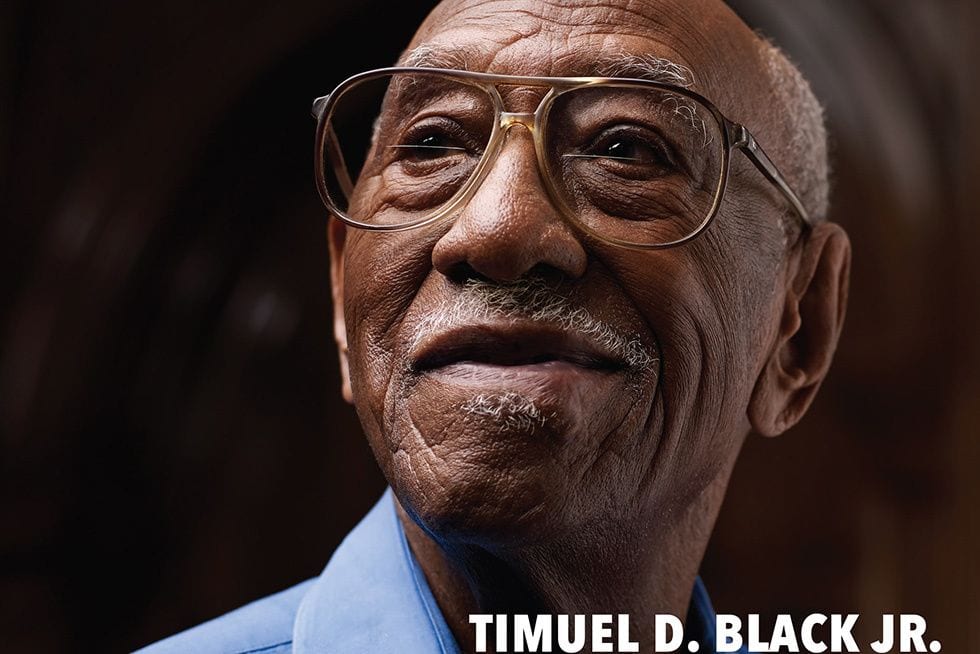
People in Chicago, especially on the South and West Sides, already know. For everyone else, here’s the news: Timuel Black is a national treasure.
His remarkable life is a Zelig-like journey through 20th Century black America. His family came to Chicago in 1919 from Birmingham, Alabama, part of the first wave of the Great Migration. They arrived just after the city’s bloody 1919 “Red Summer” race riot. But Black found nourishment, richness, and inspiration growing up in the Black Belt, the dense black community that took shape on Chicago’s South Side. He served in World War II, confronting the disconnect of fighting for freedom abroad while suffering segregation at home. After the war he returned to Chicago, and became a teacher and activist. He was the first to invite Martin Luther King, Jr. to visit Chicago, and helped organize the city’s representation at the 1963 March on Washington. In the ’90s, he became an oral historian, capturing the recollections of other blacks who built lives and careers in Chicago. In the process, he became a beloved and valued figure, the closest thing Chicago has to a griot.
Yet for all his experiences, he has not abandoned his love and attachment for his native South Side. He still remembers the places where he lived, worked and played, and the many friends and figures who shaped his life. “For me, to this day, that particular neighborhood of Chicago is my Sacred Ground,” he says in his memoir by the same title. “When I walk those streets I can stop and look at the buildings where we lived. I can remember faces, voices, melodies from my loved ones on these streets.”
It’s almost as if, after compiling two volumes of oral histories (Bridges of Memory: Chicago’s First Wave of Black Migration and Bridges of Memory: Chicago’s Second Generation of Black Migration, Northwestern University Press, 2005 and 2008), he turned the microphone around and recorded his own amazing tale. Sacred Ground: The Chicago Streets of Timuel Black captures with amazing detail the legendary black folk around him throughout his youth (he went to high school with Nat Cole, before the musician gained the nickname “King”), and ticks off place after place where he lived, worked and hung out; one might want to have a South Side map nearby to help visualize all the spots.
Black also recounts his activist work as a union organizer, and a teacher who fought for including black history in the curricula where he taught. That work also included working to elect Harold Washington as Chicago’s first black mayor in 1983, and witnessing the maturation of a young Chicago transplant named Barack Obama from wide-eyed community organizer to President of the United States.
Yet Black humbly submits his story is not all that special. “Our community possessed great assets: a motherlode of talent, a deep well of creative and entrepreneurial energy, and intellectual power, all compressed in a relatively small geographic area,” he writes. “We grew up surrounded by cultural and commercial genius, by inventors and rebels and hard-working folk, many of whom went unheralded outside of our community (and uncompensated) during their lifetimes. We had people who came from the South with nothing but a change of clothes and a Bible and who ended up establishing fortunes, and others who emerged as leaders by sheer force of personality and vision. I was lucky to be surrounded by such individuals.”
Black recently turned 100, and shows no sign of slowing down. He still gives tours of his Sacred Ground, and hasn’t completely abandoned work on a third volume, working title Bridges of Memory. He’s regularly consulted by both students seeking to learn about their place in Chicago’s history, and politicians seeking to kiss his ring. If the tail end of Sacred Ground reads like a victory lap with glowing dedications from Obama and U.S. Senator Dick Durbin, so be it: he’s more than earned the privilege.
Reading Sacred Ground isn’t quite the same as reading a formal history of black Chicago, but it’s a vivid supplement that gives life to a dry recitation of dates and names. Black’s love for his home is palpable, and his commitment to his people is enduring:
“…it’s been my fantasy, probably since I left Birmingham at eight months of age, that when I got to Chicago, it was gonna be a better world. We’re not completely there yet, but we are certainly a lot further along thanks to our shared dream. That may sound simplistic, but at my advanced age, that part of my vision carries me forward and invigorates me. When I go home tonight I’ll do my own jazz set while consuming a little glass of merlot. I put on a record and play like I’m in a jazz set with friends…The music carries that spirit of believing and knowing that tomorrow will be a better day, but we must make it a better day not just for ourselves but for others, and share the beauty of life, not just the booty of life. I’ve been lucky to physically survive to this ripe old age and to remain twenty-three in my heart.”
Indeed, so are we all.


